The Use of Right Angle Fluorescence Spectroscopy to Distinguish the Botanical Origin of Greek Common Honey Varieties
Abstract
1. Introduction
2. Materials and Methods
2.1. Honey Samples
2.2. Reagents and Solutions
2.3. Fluorescence Spectroscopy
2.4. Physicochemical and Melissopalynological Analysis
2.5. Statistical Analysis
3. Results and Discussion
3.1. Physicochemical and Melissopalynological Analysis
3.2. 3D-EEM Spectra of Standards Phenolic Compounds
3.3. 3D-EEM Spectra of Honey Samples
3.4. Stepwise-LDA of Fluorescence Spectra
4. Conclusions
Supplementary Materials
Author Contributions
Funding
Institutional Review Board Statement
Informed Consent Statement
Data Availability Statement
Conflicts of Interest
References
- Greek Ministry of Rural Development and Food. 2020. Available online: https://ec.europa.eu/info/food-farming-fisheries/animals-and-animal-products/animal-products/honey_en (accessed on 2 April 2021).
- EU. Council Directive 2001/110/EC of 20 December 2001 Relating to Honey. Off. J. Eur. Communities 2002, 10, 47–52. Available online: https://eur-lex.europa.eu/LexUriServ/LexUriServ.do?uri=OJ:L:2002:010:0047:0052:EN:PDF (accessed on 2 April 2021).
- Government Gazette B-239/23-2-2005 Annex II article 67 of Greek Food Code. 2005. Available online: http://www.minagric.gr/images/stories/docs/agrotis/MeliMelissokomia/KYA_Taytopoiisi.pdf (accessed on 2 April 2021).
- Xagoraris, M.; Lazarou, E.; Kaparakou, E.H.; Alissandrakis, E.; Tarantilis, P.A.; Pappas, C.S. Botanical origin discrimination of Greek honeys: Physicochemical parameters versus Raman spectroscopy. J. Sci. Food Agric. 2021. [Google Scholar] [CrossRef]
- Gok, S.; Severcan, M.; Goormaghtigh, E.; Kandemir, I.; Severcan, F. Differentiation of Anatolian honey samples from different botanical origins by ATR-FTIR spectroscopy using multivariate analysis. Food Chem. 2015, 170, 234–240. [Google Scholar] [CrossRef] [PubMed]
- Xagoraris, M.; Revelou, P.-K.; Dedegkika, S.; Kanakis, C.D.; Papadopoulos, G.K.; Pappas, C.S.; Tarantilis, P.A. SPME-GC-MS and FTIR-ATR spectroscopic study as a tool for unifloral common Greek honeys’ botanical origin identification. Appl. Sci. 2021, 11, 3159. [Google Scholar] [CrossRef]
- Chen, L.; Wang, J.; Ye, Z.; Zhao, J.; Xue, X.; Heyden, Y.V.; Sun, Q. Classification of Chinese honeys according to their floral origin by near infrared spectroscopy. Food Chem. 2012, 135, 338–342. [Google Scholar] [CrossRef] [PubMed]
- Corvucci, F.; Nobili, L.; Melucci, D.; Grillenzoni, F.-V. The discrimination of honey origin using melissopalynology and Raman spectroscopy techniques coupled with multivariate analysis. Food Chem. 2015, 169, 297–304. [Google Scholar] [CrossRef] [PubMed]
- Zheng, X.; Zhao, Y.; Wu, H.; Dong, J.; Feng, J. Origin identification and quantitative analysis of honeys by nuclear magnetic resonance and chemometric techniques. Food Anal. Methods 2015, 9, 1470–1479. [Google Scholar] [CrossRef]
- Strasburg, G.M.; Ludescher, R.D. Theory and applications of fluorescence spectroscopy in food research. Trends Food Sci. Technol. 1995, 6, 69–75. [Google Scholar] [CrossRef]
- Ghosh, N.; Verma, Y.; Majumder, S.K.; Gupta, P.K. A fluorescence spectroscopic study of honey and cane sugar syrup. Food Sci. Technol. Res. 2005, 11, 59–62. [Google Scholar] [CrossRef]
- Nikolova, K.; Eftimov, T.; Aladjadjiyan, A. Fluorescence spectroscopy as method for quality control of honey. Adv. Res. 2014, 2, 95–108. [Google Scholar] [CrossRef]
- Dramićanin, T.; Lenhardt Acković, L.; Zeković, I.; Dramićanin, M.D. Detection of adulterated honey by fluorescence excitation-emission matrices. J. Spectrosc. (Hindawi) 2018, 1–6. [Google Scholar] [CrossRef]
- Ruoff, K.; Karoui, R.; Dufour, E.; Luginbühl, W.; Bosset, J.-O.; Bogdanov, S.; Amadò, R. Authentication of the botanical origin of honey by front-face fluorescence spectroscopy. A preliminary study. J. Agric. Food Chem. 2005, 53, 1343–1347. [Google Scholar] [CrossRef]
- Karoui, R.; Dufour, E.; Bosset, J.-O.; De Baerdemaeker, J. The use of front face fluorescence spectroscopy to classify the botanical origin of honey samples produced in Switzerland. Food Chem. 2007, 101, 314–323. [Google Scholar] [CrossRef]
- Mehretie, S.; Al Riza, D.F.; Yoshito, S.; Kondo, N. Classification of raw Ethiopian honeys using front face fluorescence spectra with multivariate analysis. Food Control 2018, 84, 83–88. [Google Scholar] [CrossRef]
- Ali, H.; Khan, S.; Ullah, R.; Khan, B. Fluorescence fingerprints of Sidr honey in comparison with uni/polyfloral honey samples. Eur. Food Res. Technol. 2020. [Google Scholar] [CrossRef]
- Ruoff, K.; Luginbühl, W.; Künzli, R.; Bogdanov, S.; Bosset, J.O.; von der Ohe, K.; von der Ohe, W.; Amadò, R. Authentication of the botanical and geographical origin of honey by front-face fluorescence spectroscopy. J. Agric. Food Chem. 2006, 54, 6858–6866. [Google Scholar] [CrossRef]
- Bong, J.; Loomes, K.M.; Schlothauer, R.C.; Stephens, J.M. Fluorescence markers in some New Zealand honeys. Food Chem. 2016, 192, 1006–1014. [Google Scholar] [CrossRef]
- Stephens, J.M.; Loomes, K.M.; Braggins, T.J.; Bong, J.; Lin, B.; Prijic, G. Fluorescence: A novel method for determining manuka honey floral purity. In Honey Analysis; de Toledo, V.d.A.A., Ed.; Intech: Rijeka, Croatia, 2017; pp. 95–113. [Google Scholar] [CrossRef]
- Lastra-Mejías, M.; Torreblanca-Zanca, A.; Aroca-Santos, R.; Cancilla, J.C.; Izquierdo, J.G.; Torrecilla, J.S. Characterization of an array of honeys of different types and botanical origins through fluorescence emission based on LEDs. Talanta 2018, 185, 196–202. [Google Scholar] [CrossRef]
- Lenhardt, L.; Zeković, I.; Dramićanin, T.; Dramićanin, M.D.; Bro, R. Determination of the botanical origin of honey by front-face synchronous fluorescence spectroscopy. Appl. Spectrosc. 2014, 68, 557–563. [Google Scholar] [CrossRef]
- Lenhardt, L.; Bro, R.; Zeković, I.; Dramićanin, T.; Dramićanin, M.D. Fluorescence spectroscopy coupled with PARAFAC and PLS DA for characterization and classification of honey. Food Chem. 2015, 175, 284–291. [Google Scholar] [CrossRef]
- Parri, E.; Santinami, G.; Domenici, V. Front-face fluorescence of honey of different botanic origin: A case study from Tuscany (Italy). Appl. Sci. 2020, 10, 1776. [Google Scholar] [CrossRef]
- Ramanauskiene, K.; Stelmakiene, A.; Briedis, V.; Ivanauskas, L.; Jakštas, V. The quantitative analysis of biologically active compounds in Lithuanian honey. Food Chem. 2012, 132, 1544–1548. [Google Scholar] [CrossRef] [PubMed]
- Sergiel, I.; Pohl, P.; Biesaga, M.; Mironczyk, A. Suitability of three-dimensional synchronous fluorescence spectroscopy for fingerprint analysis of honey samples with reference to their phenolic profiles. Food Chem. 2014, 145, 319–326. [Google Scholar] [CrossRef]
- Mattonai, M.; Parri, E.; Querci, D.; Degano, I.; Ribechini, E. Development and validation of an HPLC-DAD and HPLC/ESI-MS 2 method for the determination of polyphenols in monofloral honeys from Tuscany (Italy). Microchem. J. 2016, 126, 220–229. [Google Scholar] [CrossRef]
- Cheung, Y.; Meenu, M.; Yu, X.; Xu, B. Phenolic acids and flavonoids profiles of commercial honey from different floral sources and geographic sources. Int. J. Food Prop. 2019, 22, 290–308. [Google Scholar] [CrossRef]
- Bahram, M.; Bro, R.; Stedmon, C.; Afkhami, A. Handling of Rayleigh and Raman scatter for PARAFAC modeling of fluorescence data using interpolation. J. Chemom. 2006, 20, 99–105. [Google Scholar] [CrossRef]
- Helrich, K. Official Methods of Analysis of Association of Official Analytical Chemists, 15th ed.; Helrich, K., Ed.; Association of Official Analytical Chemists: Arlington, VA, USA, 1990; Volume 1. [Google Scholar]
- Harmonides Methods of the International Honey Commission. ICH Responsible for the Methods; Bee Product Science; Harmonides Methods of the International Honey Commission; Bogdanov, S., Ed.; Swiss Bee Research Centre FAM: Bern, Switzerland, 2009; Available online: https://www.ihc-platform.net/ihcmethods2009.pdf (accessed on 2 April 2021).
- Louveaux, J.; Maurizio, A.; Vorwohl, G. Methods of melissopalynology. Bee World 1978, 59, 139–157. [Google Scholar] [CrossRef]
- Stevens, P.J. Applied Multivariate Statistics for the Social Sciences, 3rd ed.; Lawrence Erlbaum: Mahwah, NJ, USA, 1996. [Google Scholar]
- Kivima, E.; Seiman, A.; Pall, R.; Sarapuu, E.; Martverk, K.; Laos, K. Characterization of Estonian honeys by botanical origin. Proc. Est. Acad. Sci. 2014, 63, 183. [Google Scholar] [CrossRef]
- Li, Y.-Q.; Li, X.-Y.; Shindi, A.A.F.; Zou, Z.-X.; Liu, Q.; Lin, L.-R.; Li, N. Synchronous fluorescence spectroscopy and its applications in clinical analysis and food safety evaluation. In Reviews in Fluorescence; Geddes, C.D., Lakowicz, J.R., Eds.; Springer: New York, NY, USA, 2011; pp. 95–117. [Google Scholar] [CrossRef]
- Pichichero, E.; Canuti, L.; Canini, A. Characterisation of the phenolic and flavonoid fractions and antioxidant power of Italian honeys of different botanical origin. J. Sci. Food Agric. 2009, 89, 609–616. [Google Scholar] [CrossRef]
- Spilioti, E.; Jaakkola, M.; Tolonen, T.; Lipponen, M.; Virtanen, V.; Chinou, I.; Kassi, E.; Karabournioti, S.; Moutsatsou, P. Phenolic acid composition, antiatherogenic and anticancer potential of honeys derived from various regions in Greece. PLoS ONE 2014, 9, e94860. [Google Scholar] [CrossRef]
- Liang, Y.; Cao, W.; Chen, W.; Xiao, X.; Zheng, J. Simultaneous determination of four phenolic components in citrus honey by high performance liquid chromatography using electrochemical detection. Food Chem. 2009, 114, 1537–1541. [Google Scholar] [CrossRef]
- Perna, A.; Intaglietta, I.; Simonetti, A.; Gambacorta, E. A comparative study on phenolic profile, vitamin C content and antioxidant activity of Italian honeys of different botanical origin. Int. J. Food Sci. Technol. 2013, 48, 1899–1908. [Google Scholar] [CrossRef]
- Mannina, L.; Sobolev, A.P.; Di Lorenzo, A.; Vista, S.; Tenore, G.C.; Daglia, M. Chemical composition of different botanical origin honeys produced by Sicilian black honeybees (Apis mellifera ssp. sicula). J. Agric. Food Chem. 2015, 63, 5864–5874. [Google Scholar] [CrossRef] [PubMed]
- Hadjmohammadi, M.R.; Nazari, S.S.S.J. Separation optimization of quercetin, hesperetin and chrysin in honey by micellar liquid chromatography and experimental design. J. Sep. Sci. 2010, 33, 3144–3151. [Google Scholar] [CrossRef] [PubMed]
- Trautvetter, S.; Koelling-Speer, I.; Speer, K. Confirmation of phenolic acids and flavonoids in honeys by UPLC-MS. Apidologie 2009, 40, 140–150. [Google Scholar] [CrossRef]
- Socha, R.; Juszczak, L.; Pietrzyk, S.; Fortuna, T. Antioxidant activity and phenolic composition of herbhoneys. Food Chem. 2009, 113, 568–574. [Google Scholar] [CrossRef]
- Tsiapara, A.V.; Jaakkola, M.; Chinou, I.; Graikou, K.; Tolonen, T.; Virtanen, V.; Moutsatsou, P. Bioactivity of Greek honey extracts on breast cancer (MCF-7), prostate cancer (PC-3) and endometrial cancer (Ishikawa) cells: Profile analysis of extracts. Food Chem. 2009, 116, 702–708. [Google Scholar] [CrossRef]
- Kıvrak, Ş.; Kıvrak, İ. Assessment of phenolic profile of Turkish honeys. Int. J. Food Prop. 2016, 20, 864–876. [Google Scholar] [CrossRef]
- Pita-Calvo, C.; Vázquez, M. Differences between honeydew and blossom honeys: A review. Trends Food Sci. Technol. 2017, 59, 79–87. [Google Scholar] [CrossRef]
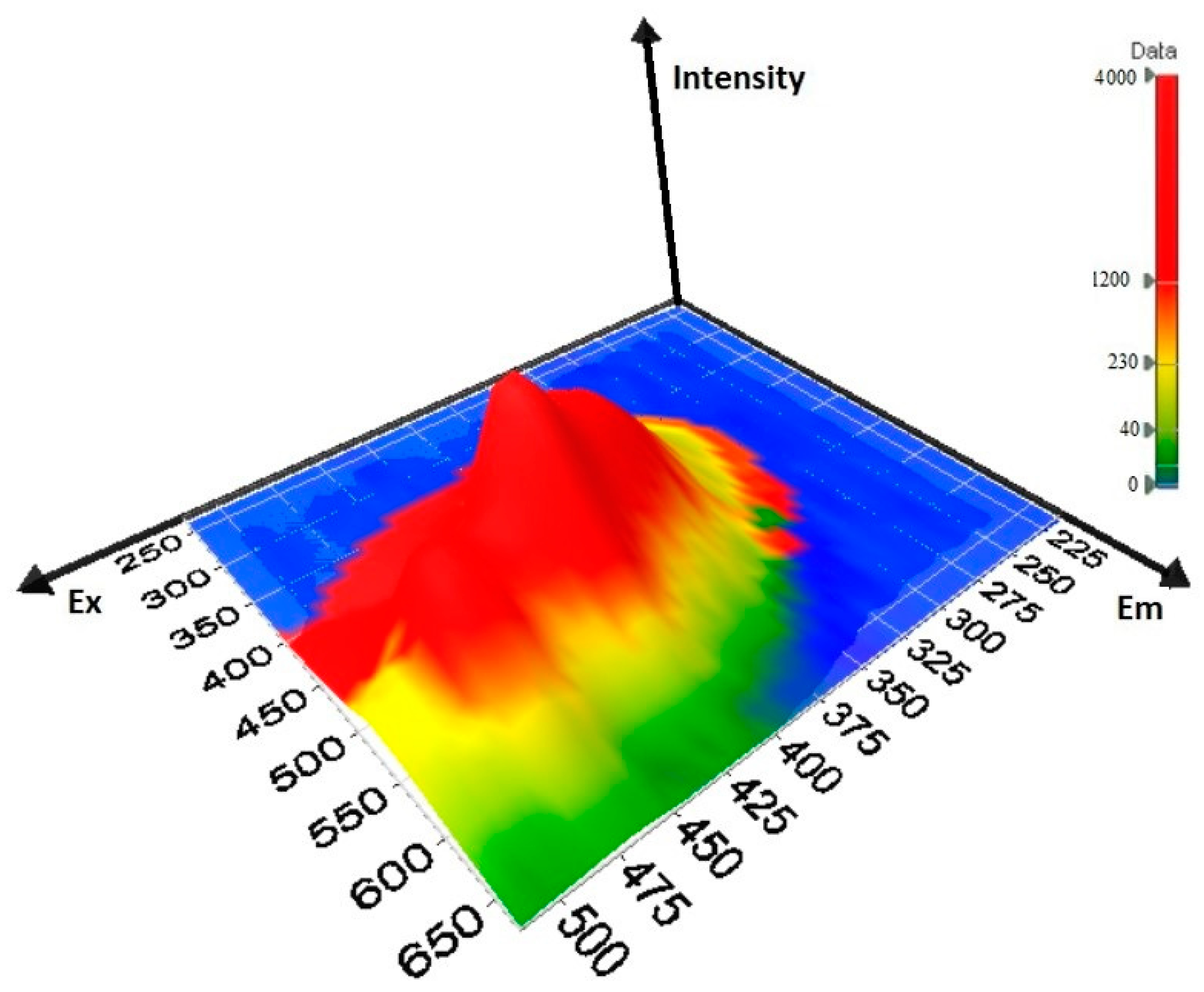
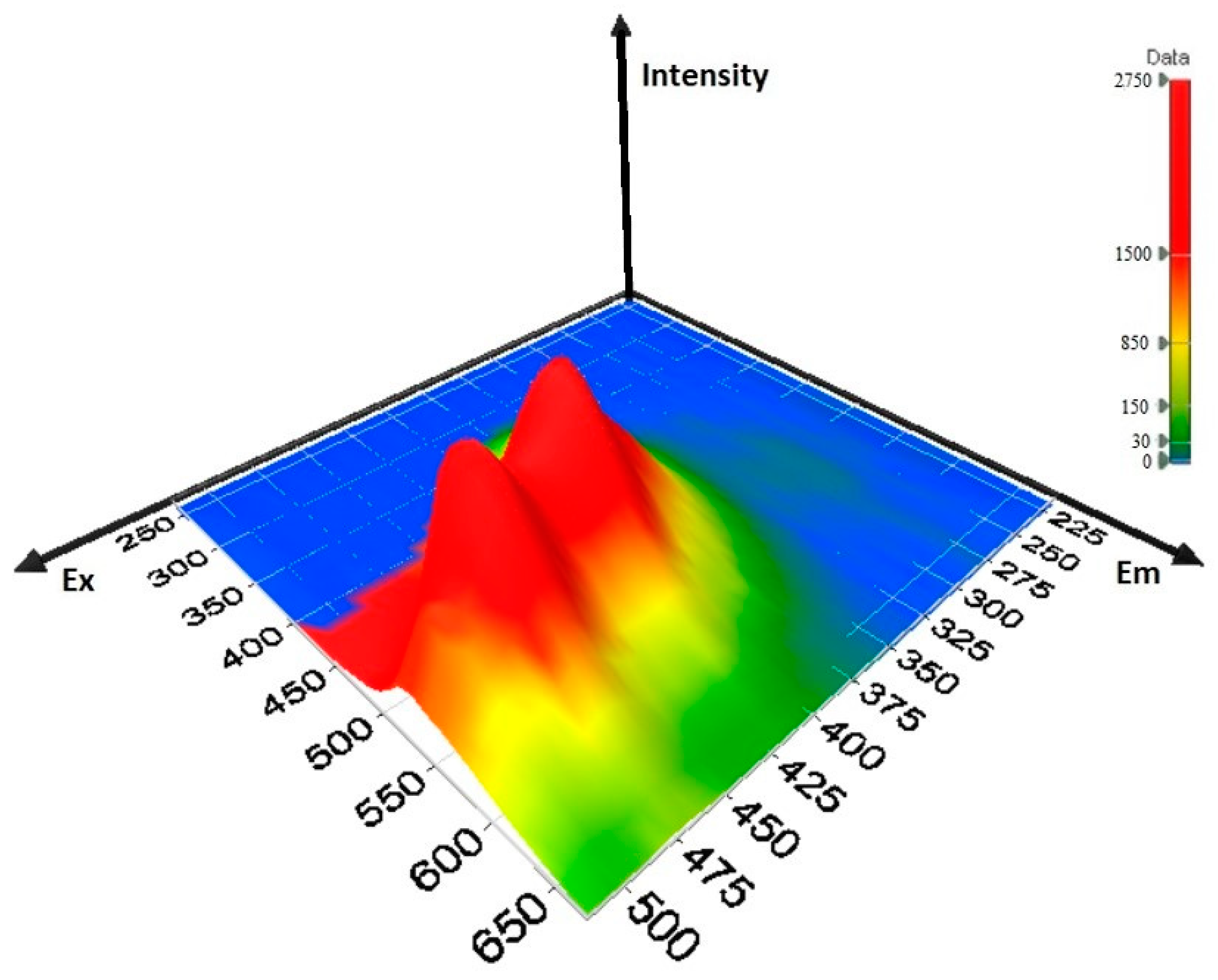
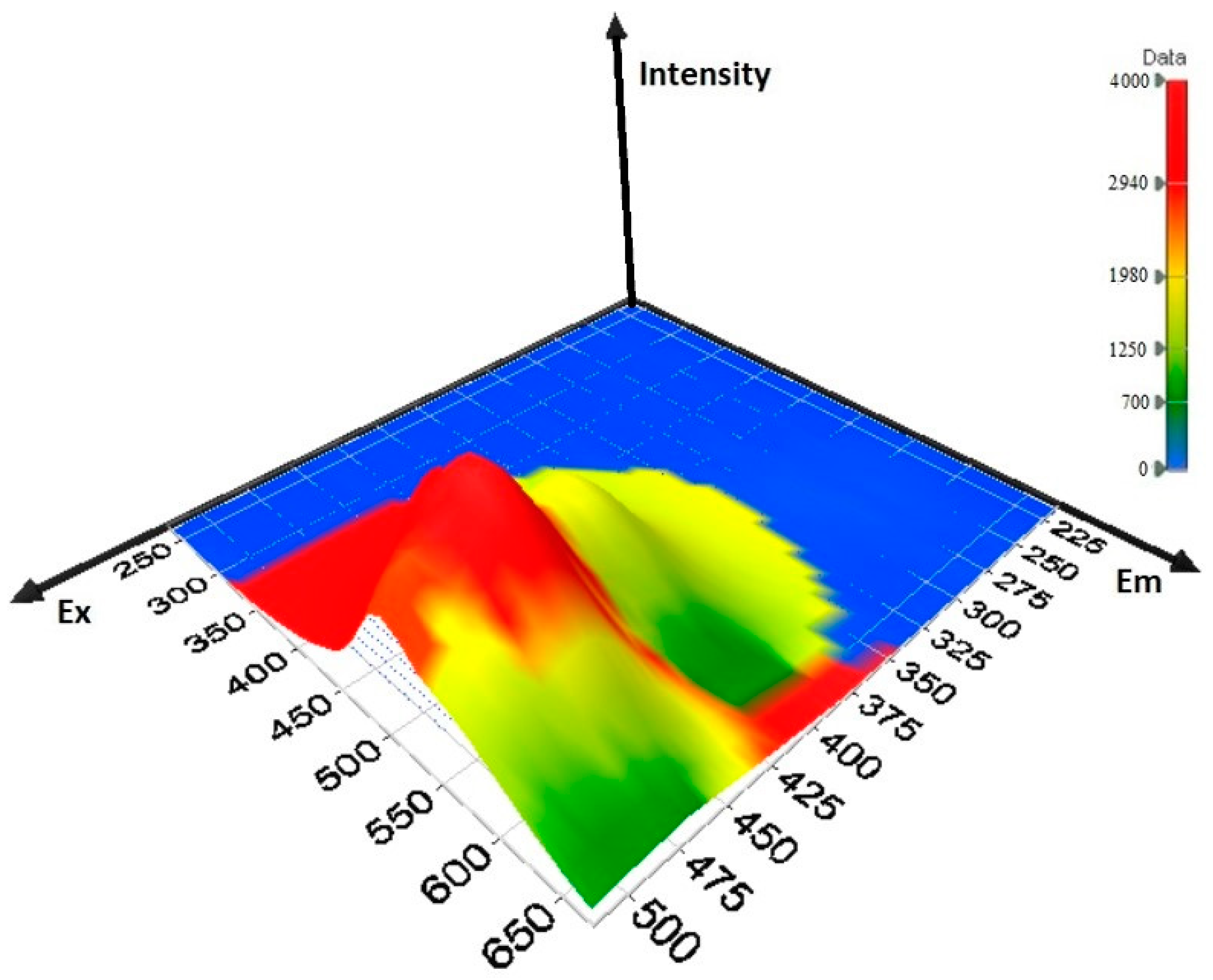
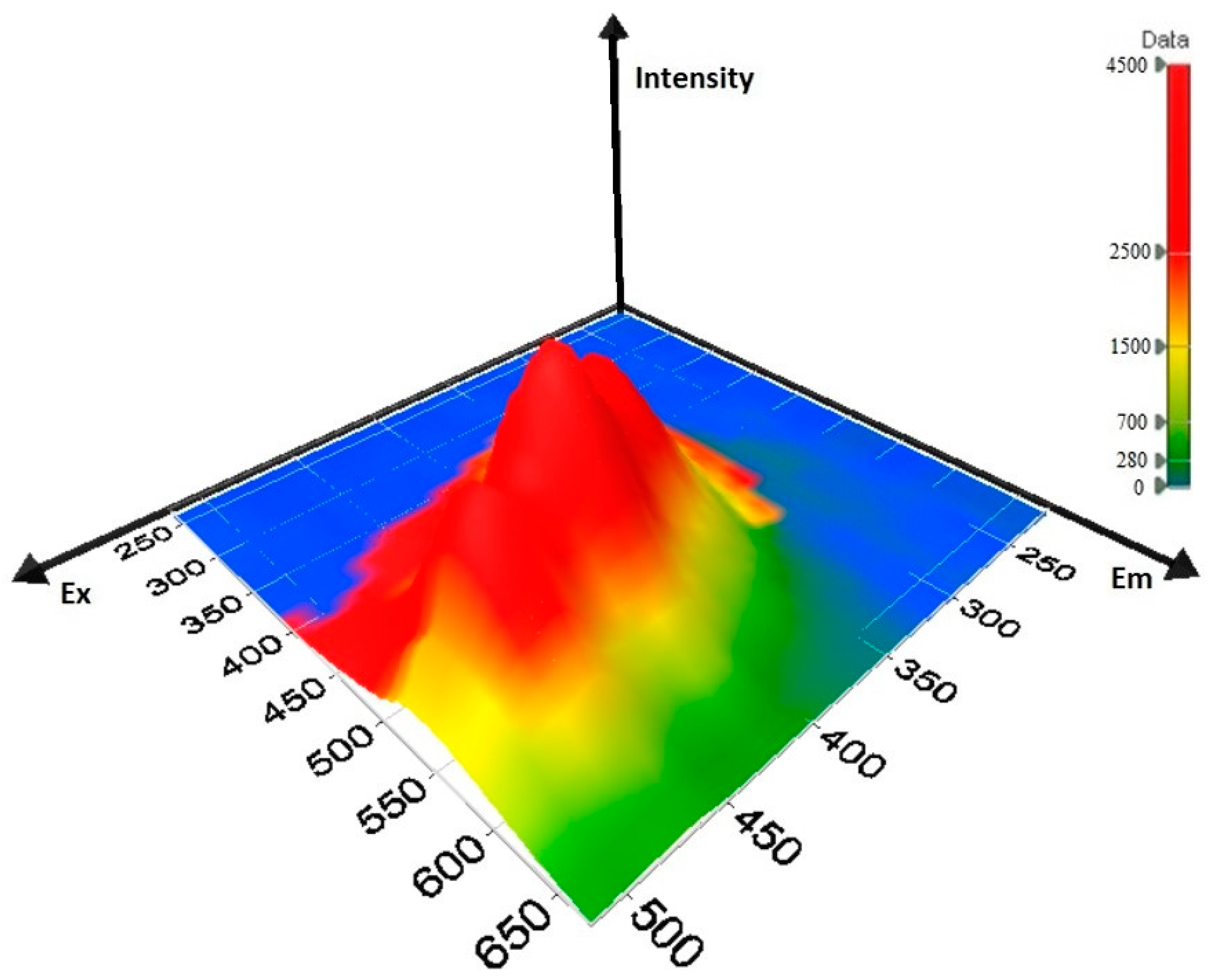
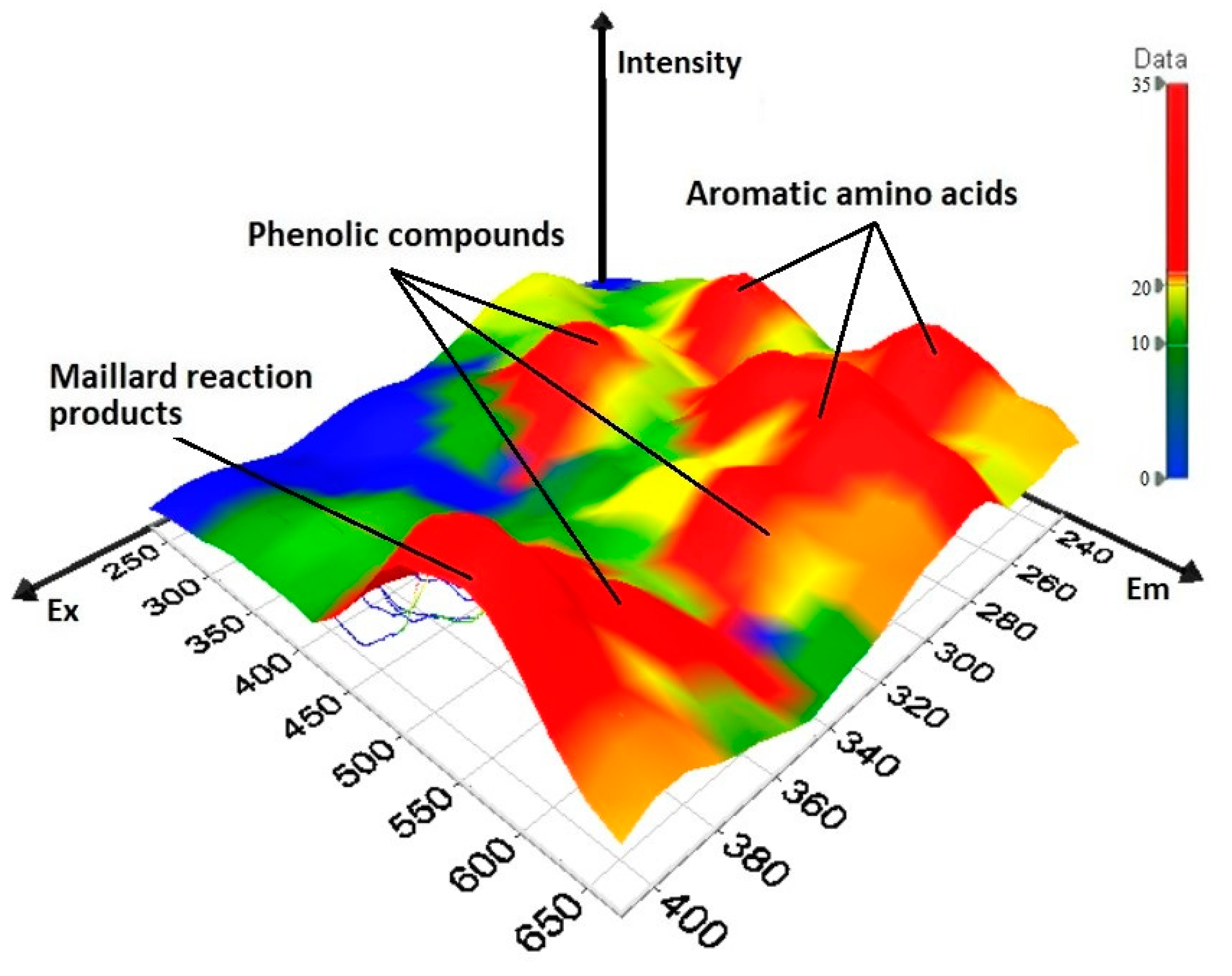
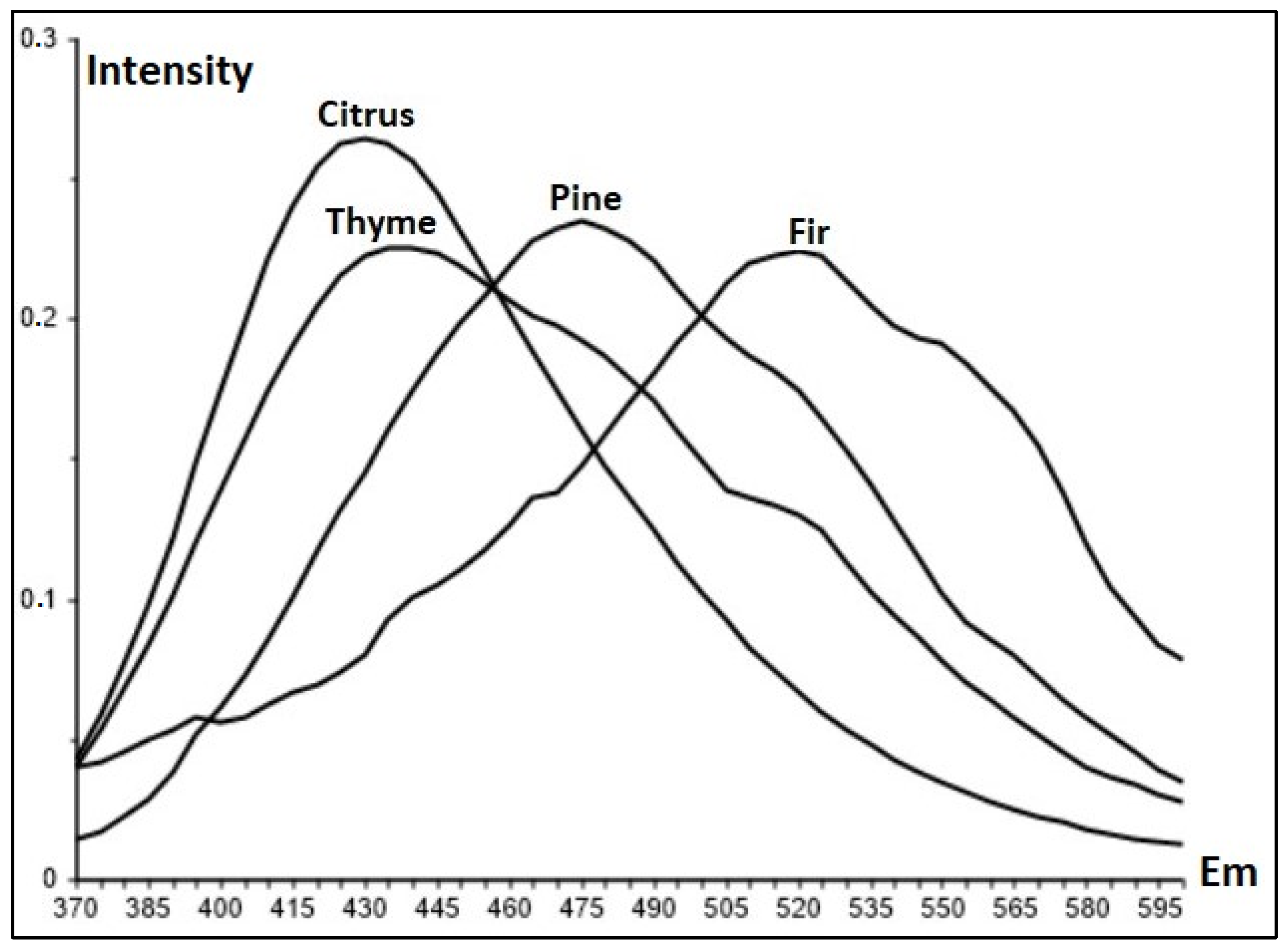
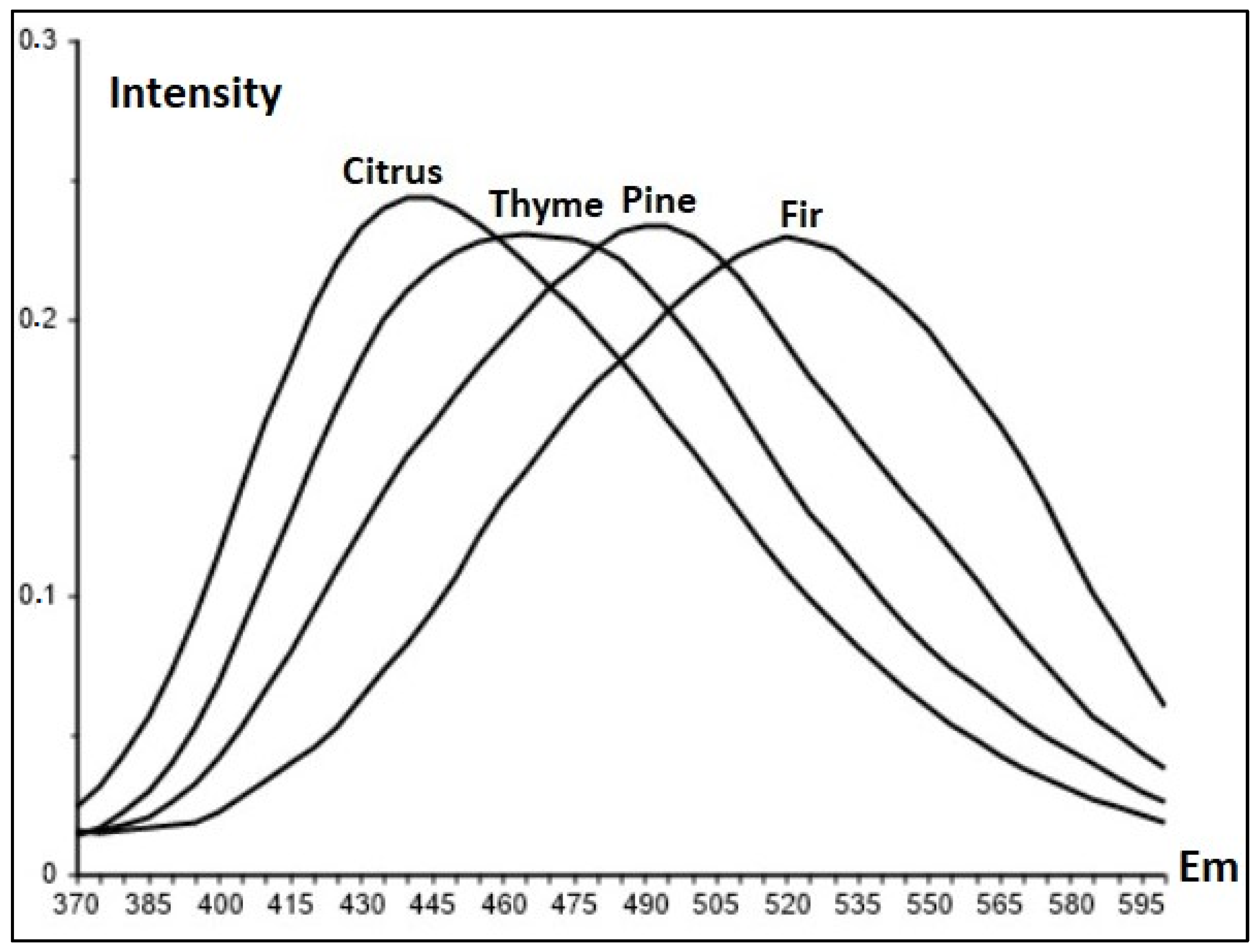
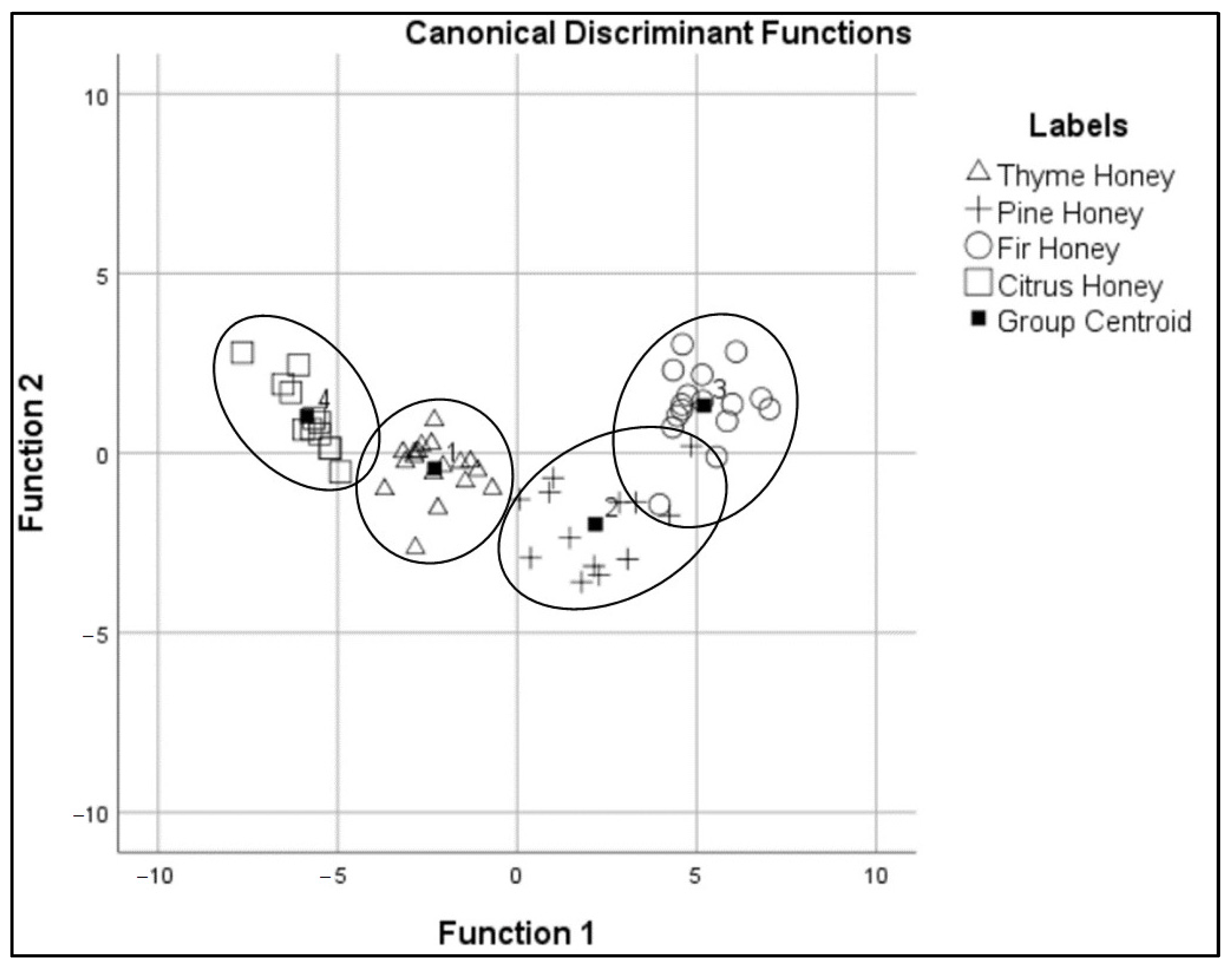

| Botanical Source | Aggregate Functions | Fructose + Glucose (%w/w) | Sucrose (%w/w) | Electrical Conductivity (μS cm−1) | Moisture (%w/w) |
|---|---|---|---|---|---|
| Thyme honey | Min | 60.1 | 0.0 | 251 | 14.3 |
| Max | 86.4 | 3.7 | 600 | 17.9 | |
| Average | 68.2 | 0.7 | 435 | 15.8 | |
| Pine honey | Min | 46.4 | 0.0 | 911 | 14.6 |
| Max | 77.2 | 1.0 | 1431 | 17.7 | |
| Average | 58.9 | 0.1 | 1122 | 16.1 | |
| Fir honey | Min | 46.3 | 0.0 | 1041 | 13.7 |
| Max | 64.5 | 2.4 | 2000 | 18.4 | |
| Average | 55.0 | 0.2 | 1526 | 15.5 | |
| Citrus honey | Min | 66.2 | 0.0 | 181 | 15.3 |
| Max | 76.2 | 4.8 | 324 | 18.7 | |
| Average | 71.9 | 1.0 | 275 | 17.0 |
| Phenolic Compound | λex (nm) | λem (nm) |
|---|---|---|
| Caffeic acid | 310–360 | 410 |
| Chlorogenic acid | 300–360 | 416 |
| p-Coumaric acid | 320–340 | 380 |
| Ferulic acid | 310–360 | 400 |
| Sinapic acid | 300–360 | 415 |
| Ellagic acid | 280–380 | 400 |
| Homogentisic acid | 280–320 | 335 |
| Gallic acid | 265–315 | 345 |
| Protocatechuic acid | 265–315 | 335 |
| Syringic acid | 250–315 | 335 |
| Vanillic acid | 260–315 | 330 |
| Methyl syringate | 250–320 | 340 |
| Gentisic acid | 290–360 | 400 and 475 |
| Kaempferol | 280–320 | 430 and 500 |
| Catechin | 250–310 | 315 |
| Chrysin | Low intensity | |
| Hesperetin | Low intensity | |
| Isorhamentin | Low intensity | |
| Naringenin | Low intensity | |
| Predicted Group Membership | |||||||
|---|---|---|---|---|---|---|---|
| Labels | Thyme Honey | Pine Honey | Fir Honey | Citrus Honey | Total | ||
| Original a | Count | Thyme honey | 18 | 0 | 0 | 0 | 18 |
| Pine honey | 1 | 11 | 1 | 0 | 13 | ||
| Fir honey | 0 | 1 | 15 | 0 | 16 | ||
| Citrus honey | 0 | 0 | 0 | 12 | 12 | ||
| % | Thyme honey | 100.0 | 0.0 | 0.0 | 0.0 | 100.0 | |
| Pine honey | 7.7 | 84.6 | 7.7 | 0.0 | 100.0 | ||
| Fir honey | 0.0 | 6.3 | 93.8 | 0.0 | 100.0 | ||
| Citrus honey | 0.0 | 0.0 | 0.0 | 100.0 | 100.0 | ||
| Cross-validated b,c | Count | Thyme honey | 18 | 0 | 0 | 0 | 18 |
| Pine honey | 1 | 11 | 1 | 0 | 13 | ||
| Fir honey | 0 | 1 | 15 | 0 | 16 | ||
| Citrus honey | 0 | 0 | 0 | 12 | 12 | ||
| % | Thyme honey | 100.0 | 0.0 | 0.0 | 0.0 | 100.0 | |
| Pine honey | 7.7 | 84.6 | 7.7 | 0.0 | 100.0 | ||
| Fir honey | 0.0 | 6.3 | 93.8 | 0.0 | 100.0 | ||
| Citrus honey | 0.0 | 0.0 | 0.0 | 100.0 | 100.0 | ||
| External Validation d | Count | Thyme honey | 11 | 0 | 3 | 0 | 14 |
| Pine honey | 1 | 4 | 0 | 0 | 5 | ||
| Fir honey | 0 | 1 | 4 | 0 | 5 | ||
| Citrus honey | 0 | 0 | 0 | 4 | 4 | ||
| % | Thyme honey | 78.6 | 0.0 | 21.4 | 0 | 100.0 | |
| Pine honey | 20.0 | 80.0 | 0.0 | 0 | 100.0 | ||
| Fir honey | 0.0 | 20.0 | 80.0 | 0 | 100.0 | ||
| Citrus honey | 0.0 | 0.0 | 0.0 | 100.0 | 100.0 | ||
| Predicted Group Membership | |||||||
|---|---|---|---|---|---|---|---|
| Labels | Thyme Honey | Pine Honey | Fir Honey | Citrus Honey | Total | ||
| Original a | Count | Thyme honey | 17 | 1 | 0 | 0 | 18 |
| Pine honey | 0 | 10 | 3 | 0 | 13 | ||
| Fir honey | 0 | 6 | 10 | 0 | 16 | ||
| Citrus honey | 1 | 0 | 0 | 11 | 12 | ||
| % | Thyme honey | 94.4 | 5.6 | 0.0 | 0.0 | 100.0 | |
| Pine honey | 0.0 | 76.9 | 23.1 | 0.0 | 100.0 | ||
| Fir honey | 0.0 | 37.5 | 62.5 | 0.0 | 100.0 | ||
| Citrus honey | 8.3 | 0.0 | 0.0 | 91.7 | 100.0 | ||
| Cross-validated b,c | Count | Thyme honey | 17 | 1 | 0 | 0 | 18 |
| Pine honey | 0 | 10 | 3 | 0 | 13 | ||
| Fir honey | 0 | 6 | 10 | 0 | 16 | ||
| Citrus honey | 2 | 0 | 0 | 10 | 12 | ||
| % | Thyme honey | 94.4 | 5.6 | 0.0 | 0.0 | 100.0 | |
| Pine honey | 0.0 | 76.9 | 23.1 | 0.0 | 100.0 | ||
| Fir honey | 0.0 | 37.5 | 62.5 | 0.0 | 100.0 | ||
| Citrus honey | 16.7 | 0.0 | 0.0 | 83.3 | 100.0 | ||
| External Validation d | Count | Thyme honey | 10 | 4 | 0 | 0 | 14 |
| Pine honey | 0 | 5 | 0 | 0 | 5 | ||
| Fir honey | 0 | 1 | 4 | 0 | 5 | ||
| Citrus honey | 0 | 0 | 0 | 4 | 4 | ||
| % | Thyme honey | 71.4 | 28.6 | 0.0 | 0.0 | 100.0 | |
| Pine honey | 0.0 | 100.0 | 0.0 | 0.0 | 100.0 | ||
| Fir honey | 0.0 | 20.0 | 80.0 | 0.0 | 100.0 | ||
| Citrus honey | 0.0 | 0.0 | 0.0 | 100.0 | 100.0 | ||
Publisher’s Note: MDPI stays neutral with regard to jurisdictional claims in published maps and institutional affiliations. |
© 2021 by the authors. Licensee MDPI, Basel, Switzerland. This article is an open access article distributed under the terms and conditions of the Creative Commons Attribution (CC BY) license (https://creativecommons.org/licenses/by/4.0/).
Share and Cite
Xagoraris, M.; Revelou, P.-K.; Alissandrakis, E.; Tarantilis, P.A.; Pappas, C.S. The Use of Right Angle Fluorescence Spectroscopy to Distinguish the Botanical Origin of Greek Common Honey Varieties. Appl. Sci. 2021, 11, 4047. https://doi.org/10.3390/app11094047
Xagoraris M, Revelou P-K, Alissandrakis E, Tarantilis PA, Pappas CS. The Use of Right Angle Fluorescence Spectroscopy to Distinguish the Botanical Origin of Greek Common Honey Varieties. Applied Sciences. 2021; 11(9):4047. https://doi.org/10.3390/app11094047
Chicago/Turabian StyleXagoraris, Marinos, Panagiota-Kyriaki Revelou, Eleftherios Alissandrakis, Petros A. Tarantilis, and Christos S. Pappas. 2021. "The Use of Right Angle Fluorescence Spectroscopy to Distinguish the Botanical Origin of Greek Common Honey Varieties" Applied Sciences 11, no. 9: 4047. https://doi.org/10.3390/app11094047
APA StyleXagoraris, M., Revelou, P.-K., Alissandrakis, E., Tarantilis, P. A., & Pappas, C. S. (2021). The Use of Right Angle Fluorescence Spectroscopy to Distinguish the Botanical Origin of Greek Common Honey Varieties. Applied Sciences, 11(9), 4047. https://doi.org/10.3390/app11094047










